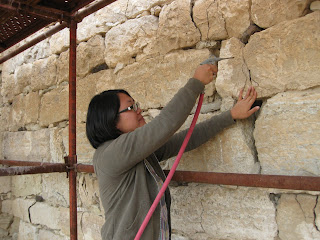 |
| Our goal: obtaining saf su. |
Distilled or deionized water is important in many treatments completed here at Gordion Excavations. Therefore, one of our first and top priorities is obtaining an appropriate source of water, which proved to be quite a challenge this season. We first attempted the deionizing columns left over from previous years, but after several rounds the conductivity of the resulting water was off the charts.
 |
| Discussing the deionizing column with a chemical salesman in Ankara. |
During a trip to Ankara, we ventured on a mission to find a local source for purchasing deionizing columns. The set up for purchasing chemicals and supplies in Ankara is rather amusing. In one section of town, there are a few strip malls with stores that sell medical, laboratory, and chemical supplies. In many ways, the experience feels like purchasing a car. The chemical salespeople contemplated the column: they tapped it, shook it, sniffed it, then called in reinforcement, who also tapped it, shook it, and sniffed it. After several visits to different stores, many confused looks, and a few phone calls, we were unsuccessful in locating a column.
 |
| Angie sets up the still outside of the lab. |
Defeated in our quest for a deionizing column, we set up the still back at the lab. Although the process is slow, after several days of running the still, we were able to obtain enough distilled water for the season. In case we run out, several small bottles of distilled water were purchased from a petrol station in Polatli, a nearby town.
 |
Feeling sorry for the water-deprived objects conservators, Gordion
archaeologists purchased these cute little bottles of distilled water. |
Perhaps next season will be more successful in the quest for purchasing a deionizing column in Turkey - a tip from an Ankara local suggested home improvement stores that may carry water filtration systems designed for the home.
With saf su in hand, Gordion objects conservators commenced with desalination and other treatments involving water.

















































